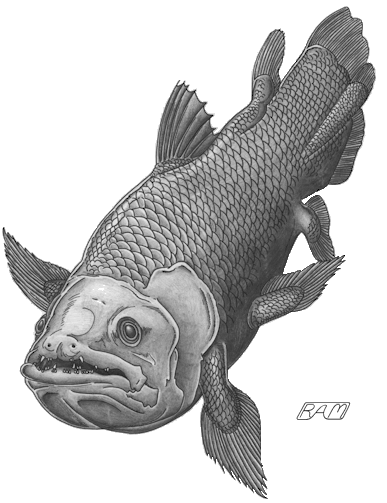The Coelacanth -
a Morphological Mixed Bag
The Coelacanth - pronounced SEE-lah-kanth - (Latimeria chalumnae) is a sarcopterygian fish that combines an odd assortment of features. Some of these features are astonishingly shark-like, others revealingly human-like, while still others are quite unlike any other living creature.
Shark-like features of the Coelacanth include:
- a large internal organ (actually the swim bladder, an organ all sharks lack) filled with low-density lipids, reducing the fish's overall density in much the same way as a shark's liver does
- a short intestine with spiral valve-like internal partitions, increasing absorptive area
- retention of high levels of urea and other metabolic wastes in the blood and a salt-excreting rectal gland allowing shark-like osmoregulation
- a shark-like pituitary gland
- large, yolky eggs and a prolonged gestation period (11 months); ovoviviparous parturition which includes formation of a pseudoplacenta at a late stage of development, as in carcharhinid sharks
- a jelly-filled gland under the nasal cartilage that is served by numerous sensory nerves and may enable the Coelacanth to detect electromagnetic fields, much like a shark using its ampullae of Lorenzini

Coelacanths are so shark-like, in fact, that it has been seriously proposed that they are closer to cartilaginous fishes than to other bony fishes; however, the preponderance of evidence does not bear out this notion.
The sarcopterygian fishes include not only the Coelacanth but also another group of 'primitive' fishes, the lungfishes (represented today by three families of elongate freshwater fishes, one each from Australia, Africa, and South America). These fishes share a unique ability to rotate their pectoral and pelvic fins, a movement that facilitated crawling out of miasmic Devonian swamps and eventually invading dry land. It is believed that the sarcopterygians gave rise to the tetrapods, a group which includes all four-footed terrestrial vertebrates: amphibians, reptiles, birds, and mammals - such as ourselves (we became secondarily bipedal, freeing our hands for all sorts of uniquely human activities - including turning pages in the book you are now reading). There has been much debate over whether the Coelacanth or one of the lungfishes is our closest ancestor among fishes. In part because we ourselves are lung-breathers, it has long been argued that the air-gulping lungfishes may be closer related to humans than the gill-breathing Coelacanth. But recent morphological evidence suggests the Coelacanth may, in fact, be the closest fishy ancestor to the terrestrial tetrapods.
German biochemists Thomas Gorr and Traute Kleinschmidt - both of the Max Planck Institute for Biochemistry at Martinsreid, Germany - recently examined the hemoglobin (oxygen-carrying protein in red blood cells) of 522 marine and terrestrial animals and concluded that there is a very close chemical match between one component of the Coelacanth's hemoglobin and its corresponding component in tadpole blood. Proponents of lungfishes as the likely ancestor of terrestrial tetrapods remain unconvinced. Bernd Fritzch - of Creighton University in Omaha, Nebraska - recently compared the detailed structure of the inner ear of a lungfish and a Coelacanth with those of tetrapods. Fritzch found that the lungfish's inner ear is fluid-filled and very like that of a shark, while that of the Coelacanth features an air bubble next to the middle ear. Such a bubble would facilitate hearing above the surface and may have been an important step toward the air-filled middle ear of terrestrial tetrapods. More recently, neuroanatomist Chris von Bartheld - of the University of Washington, in Seattle - compared the oculomotor system (brain and neural connections that control movement of the eyes) of fishes to that of tetrapods. Bartheld found that the oculomotor system of the Coelacanth was closer to that of tetrapods than that of other fishes.
Taken together, the independent work of these scientists provides several lines of compelling evidence supporting the Coelacanth as a likely candidate for the fishy progenitor of land-dwelling vertebrates. But the Coelacanth retains some features that are uniquely its own. These include:
- a hinge at the back of the skull that allows the Coelacanth to open its mouth especially wide, a hollow backbone (the name Coelacanth means "hollow spine")
- a trilobate (three-lobed) caudal fin, with upper and lower halves separated by a small secondary tail which may help the fish swim better; thick, armor-like cosmoid scales
- a tiny heart that is a more-or-less straight tube (not bent into an S-shape, as in most modern fishes)
- a braincase filled mostly with fat, embedded in which is the puny brain (occupying less than 1.5% of the braincase)
It's hard to believe that readers of this webpage could have evolved from an illiterate fathead like the Coelacanth. Maybe the Coelacanth is that long-lost relative no one in the family talks about! I won't tell if you won't.
